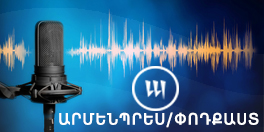Claim back all property belonging to Armenians stolen by Turks: Bodil Biørn's grandson
 11:36, 26 March 2015
11:36, 26 March 2015YEREVAN, MARCH 26, ARMENPRESS. In 1905, the “Women Missionary Organization” sent Bodil Katharine Biørn to the Ottoman Empire as a missionary nurse, but at that time the Norwegian missionary could not even imagine what impact it could have in her life.
In 1915, she witnessed the Mush massacres, including the persecution and annihilation of the orphans in her custody and the murder of numerous Armenian priests, teachers and assistants. During the genocide, while many of her colleagues reverted to the role of bystander, Bodil Katharine Biørn became a witness and a messiah; saving the lives of hundreds of homeless Armenian women and children.
Moreover, Biørn adopted a 2 years old Armenian orphan, who survived the genocide and in 1917, she took the boy named Rafael with her to Norway and baptized him as Nansen. Nansen (originally named Rafael) became her only son, as Biørn never got married in her life.
“Armenpress” introduces an exclusive interview with Bodil Katharine Biørn’s grandson Jussi Flemming Biørn.
- Do ordinary Norwegian people know about Armenian Genocide and feat of people like Bodil Biorn?
- Ordinary Norwegian people don't know about the Armenian Genocide today. In the 1920's people in Norway had more knowledge because of numerous newspaper articles by Bodil and others bring the light to the catastrophe. The attention of Fridtjof Nansen who had traveled to Armenia and the Nobel peace prize he received in1922 also made people aware of the tragedy. But then little by little it was forgotten.
- When and how did you found out the great humanitarian work that your grandmother has been done?
- I always knew about my grandmother’s work as we lived together until she died at the age of 89. I was 15 at the time.
- How did it influence on your following life?
- I grew up knowing I was 1/2 Armenian and 1/2 Finnish. But also Norwegian. I had no problem with my mixed origin. I didn't pay much attention to this growing up. I was an ordinary boy living in an ordinary family. My mother spoke a bit funny Norwegian/Swedish with Finnish accent. My father had a more exotic looks than father of my friend, but then again he spoke fluently several languages, English, French, Finnish and Arabic. I felt proud. My Armenian origin was not important at the time, because Armenia was never in the news, it was a closed country for us, part of the Soviet Union. I had an Armenian father, my mother was Finnish, I was born in Stockholm, my brother was born in Finland, my sister in Norway. My grandmother was Norwegian. I was proud of my family.
- Since 2008 when the movie “They call me mother” dedicated to your grandmother was shown in Yerevan during “Golden Apricot” international film festival, was it shown somewhere else?
- The film has been screened several times, in the movie theater in Krageroe, hometown of Bodil, in the local library, in The Danish Institute in Damascus, in the Armenian cultural centre in Aleppo, in the Naregatsi Art Institute in Yerevan and Norwegian I TV2. In addition several other occasion in Norway connected to Armenia.
- In 1917, Bodil Biorn arrived in Norway with an Armenian boy whom she named Fridtjof and who she claimed to have adopted. As we know during Christmas 2005, you have received a surprising call from an unknown person claiming to be a relative. He explained that his father, a member of the Armenian Resistance, had a short relationship with Bodil in the town of Mush. The name of this man was Ruben. Does this story have a continuation?
- It turned out that this man, whose family name was Ter-Minissian had not the DNA that could be traced to my DNA. Never the less it's more likely that his wife, Anahit's father had a relationship to Bodil, as he was from Mus. I haven't followed this trail but I still wonder what really happened during those troubled days.
- What kind of actions are needed in international recognition and condemnation of the Armenian Genocide, taking in to account the fact that 100 years after the crime it had not achieved the proper appraisal from the international society?
-The social media has proved to be a powerful weapon to change people's views and several issues have been brought in to the light both national and international. Even the politicians use Facebook and Twitter to highlite and bring forward issues they like to emphasize. Make 2015 a whole year of remembrance and don't stop at April 24. Make April 24. the beginning of international recognition like the Armenian genocide happened yesterday. Claim back all property belonging to Armenian families stolen by the Turks as the Jude's successfully have done in all Europe. Undress the Turkish propaganda every time they bribe foreign politicians and historians to falsify the history and never let them rest. It's a growing opinion in Turkey who like to recognise what happened, even give back property in order to continue as a proud people.
- Are You planning to visit Armenia and stand beside the Armenian people on a symbolic date - the anniversary of Armenian Genocide?
- I will visit Armenia on the symbolic date April 24. and take part in the ceremony in Tzitsnerkaberd. I will also bring a groupe of Norwegians, headed by the mayor of Krageroe, members of my family and friends who will experience how the Armenians from all over the world commemorate the victims of the Armenian Genocide.
Interview by Anahit Minasyan




















